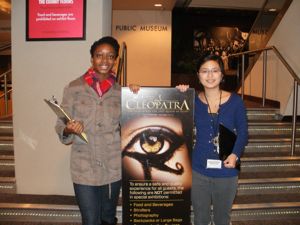|
Cleopatra: A “Must-see” Exhibit at the Milwaukee Public Museum
by Adaeze Okoli, age 18

Early on a Saturday Morning, fellow Free Press teen editor Annie Shao and I set out for the Milwaukee Public Museum. It was a nice day and this was a trip we were looking forward to very much. The exhibit we wanted to see is called, “Cleopatra: The Search for the Last Queen of Egypt.” We loved it. The exhibit transported us back to Cleopatra’s world to fully understand her life and death.
There are many myths surrounding Cleopatra’s life. Somewhere between written history and popular culture lies the truth—Cleopatra was a powerful, intelligent ruler of one of the last great ancient civilizations.
Strong leadership skills and charisma ran through Cleopatra’s veins. Her family, the Ptolemies ruled Egypt for over 275 years. The dynasty began with Ptolemy I, a Macedonian who fought alongside Alexander the Great. By the time Cleopatra began to rule, poor financial decisions had left Egypt in debt. However, Egypt thrived under Cleopatra’s rule.
At age 17, Cleopatra became queen, but her rise to power was riddled with obstacles. In order to claim the throne, she had to marry her younger brother, Ptolemy XIII. Soon after, her brother began to challenge her rule. To resolve this issue Cleopatra invited Julius Caesar to mediate. He eventually chose Cleopatra, and she was coronated at age 17.
It wasn’t long before Cleopatra became romantically involved with Julius Caesar, who was several years her senior. This relationship was also a strategic move on Cleopatra’s part. At the time, Rome was the superpower in the Mediterranean, so it was in Egypt’s best interest to maintain a strong diplomatic relationship.
Cleopatra moved to Rome with Julius Caesar, and her influence was soon apparent. Just as her people saw Cleopatra as the human incarnation of the Egyptian god Isis, Julius Caesar wanted to be seen as a living god. Unlike the Egyptian tradition, ancient Romans did not believe their leaders were living gods, and refused to worship him as such. The Roman people saw Cleopatra as a bad influence on the Roman leadership. Most did not appreciate the changes that Caesar wanted to implement. When Julius Caesar was assassinated by members of Rome’s senate, Cleopatra was forced to flee for her safety.
In 44 B.C. Cleopatra returned to Alexandria. There she continued to thrive as a ruler. As pharaoh, she commanded the navy, served as head of state, and chief foreign minister. In addition to her political affairs, Cleopatra authored books and learned nine languages.
A few years later, Mark Antony—a powerful Roman general and Caesar’s lieutenant – came to Egypt to collect taxes for his armies. Egypt and Rome had a bilateral agreement; Egypt gave Rome wheat in exchange for military protection. According to legend, Cleopatra invited Mark Antony to a lavish feast and used her charm to forge a bond. This bond proved to be crucial in Cleopatra’s opposition to Octavian becoming the ruler of Rome.
Cleopatra’s firstborn Ptolemy XV Caesarion was the son of Julius Caesar. Cleopatra strongly believed her son should become the Caesar. Caesarion’s contender was Caesar’s nephew, Octavian. Cleopatra needed a strong ally with close connections to Rome in order to prevent Octavian becoming the ruler of Rome. She found political backing and a romantic interest in Mark Antony. The Roman military leader spent much of his time in Alexandria and fathered a daughter and two sons with Cleopatra.
In opposition to Octavian, Cleopatra ordered the Egyptian navy to resist Rome’s forces. Rome defeated Cleopatra’s navy, and Cleopatra took her own life shortly thereafter.
The exhibit ended with this quote that sums up Cleopatra’s life: “Cleopatra was an intelligent, witty woman with considerable charisma who wooed and won two of the most powerful men of her day. Through her alliances, with them she maintained Egypt’s independence.”
Cleopatra’s life was filled with strategic political alliances, love affairs, and military defeat. She was one of the most powerful female figures in the ancient world and perhaps of all time. We found the current exhibit at the Milwaukee Public Museum excellent in every way. This is a fascinating must see.
Read more about Cleopatra's World of Mystery here
|

